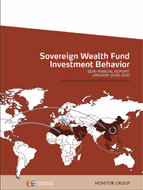FEEM-Monitor SWF Report 1H-2010
The global economic environment of the first half of 2010 was far better than that of the same period a year earlier. After withdrawing from the market during the first half of 2009, SWF investment activity picked up. At the beginning of 2010, this trend continued. During H1 2010, 16 of the 33 SWFs on the Monitor-FEEM SWF Transaction Database undertook 92 publicly reported investments with a value of $22.2 billion—double the number and value of the same period in 2009. Compared to H2 2009, the previous half year, the number of deals increased by 20 percent in H1 2010, but the value of these represented only 40 percent of the previous total. It thus appears that SWFs continued a trend we identified at the end of last year—that of making more, but smaller individual investments and (generally) taking smaller shareholdings. Additionally, the value of SWFs’ investment was depressed in comparison to H2 2009 as during H1 2010 they did not make any large domestic investments or recapitalizations such as those that inflated total expenditures in the earlier period.
However, this pattern may also signal that SWFs are being more cautious than they were six months ago, as they respond to concerns about sluggish economic growth and the possibility of a double-dip recession. For example, during the first half of 2010 we recorded only 18 announced or pending SWF investments—the same amount announced in the third quarter of 2009. This suggests that while SWFs remain active in M&A markets, they are unwilling to commit too far in advance or to announce investments before the fact.
In 2009, we noted a trend of SWFs retreating from financial services investments. During the first half of 2010 we saw a move back to this sector, with SWFs making 19 investments with a total value of $7.4 billion. However, the investment pattern was different from that in 2008, when SWFs took large equity stakes in OECD financial institutions. In 2010, SWF purchases were not, on the whole, equity stakes in banks, but rather indicate a trend towards more diverse exposure to this sector. For example, SWFs invested in private equity and investment funds focused on emerging markets or infrastructure development.
SWFs also partook in a global and accelerating M&A boomlet in energy, suggesting
that their continuing interest in natural resources is part of a wider trend in the global economy. According to Thompson Reuters the value of global investments in energy and power are up 64 percent on 2009 to $292 billion and accounted for 22 percent of all global deals in the first half of 2010. The SWFs in our database contributed 15 deals valued at $6.9 billion to these sectors during the first half of the year. A related sector in which SWFs also showed interest was mining and solid minerals. In the first six months of 2010, SWFs invested over $1.6 billion in mining companies; although most of these were listed in OECD countries (Canada, the United States and Britain) their businesses are centered on mining in emerging markets.
Among SWFs, China Investment Corporation (CIC) and Qatar Investment Agency (QIA) once again proved the most willing to make large investments. CIC made 14 publicly reported investments valued at $7.3 billion, primarily in natural resources (energy and mining) and private equity. QIA also made 14 publicly reported investments with a value of $5.5 billion, the most notable being the Raffles Hotel in Singapore and Harrods, the luxury London department store.

